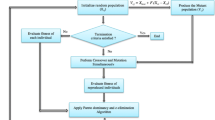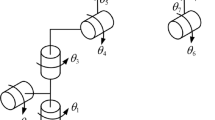Abstract
In this paper, a univariate marginal distribution algorithm in continuous domain (UMDA C ) based on extreme elitism (EEUMDA C ) is proposed for solving the inverse displacement problem (IDP) of robotic manipulators. This algorithm highlights the effect of a few top best solutions to form a primary evolution direction and obtains a fast convergence rate. Then it is implemented to determine the IDP of a 4-degree-of-freedom (DOF) Barrett WAM robotic arm. After that, the algorithm is combined with differential evolution (EEUMDA C -DE) to solve the IDP of a 7-DOF Barrett WAM robotic arm. In addition, three other heuristic optimization algorithms (enhanced leader particle swarm optimization, intersect mutation differential evolution, and evolution strategies) are applied to find the IDP solution of the 7-DOF arm and their performance is compared with that of EEUMDA C -DE.















Similar content being viewed by others
Explore related subjects
Discover the latest articles, news and stories from top researchers in related subjects.References
M. Pelikan, D.E. Goldberg, F.G. Lobo, A survey of optimization by building and using probabilistic models. Comput. Optim. Appl. 21(1), 5–20 (2002)
H. Mühlenbein, G. Paaß, From recombination of genes to the estimation of distributions I. binary parameters, in Proceedings of the 4th International Conference on Parallel Problem Solving from Nature, vol. 1141 (1996), pp. 178–187
P. Larrañaga, R. Etxeberria, J.A. Lozano, J.M. Peña, Optimization in continuous domains by learning and simulation of Gaussian networks. A Workshop within the 2000 Genetic and Evolutionary Computation Conference, Las Vegas, USA (2000)
S. Bashir, M. Maeem, A.A. Khan, S. Shah, An application of univariate marginal distribution algorithm in MIMO communication systems. Int. J. Commun Syst 23(1), 109–124 (2009)
W. Gu, Y.G. Wu, G.Y. Zhang, A hybrid univariate marginal distribution algorithm for dynamic economic dispatch of units considering valve-point effects and ramp rates. Int. Trans. Electrical Energy Syst. 25(2), 374–392 (2013)
I. Cruz-Aceves, J.G. Avina-Cervantes, J.M. Lopez-Hernandez, M.G. Garcia-Hernandez, M. Torres-Cisneros, H.J. Estrada-Garcia, A. Hernandez-Aguirre, Automatic image segmentation using active contours with univariate marginal distribution. Math. Probl. Eng. 2013, 419018 (2013). doi:10.1155/2013/419018
Y. Kang, Z.M. Wang, Y. Lin, Y. Zhang, An improved estimation of distribution algorithm for dynamic voltage scaling problem in heterogeneous system. Appl. Mech. Mater. 631, 373–377 (2014)
P. Filipiak, P. Lipinski, Univariate marginal distribution algorithm with Markov chain predictor in continuous dynamic environments, in Proceedings of 15th Conference on Intelligent Data Engineering and Automated Learning–IDEAL. vol. 8669 (2014), pp. 404–411
J. Slezak, T. Gotthans, Design of passive analog electronic circuits using hybrid modified UMDA algorithm. Radioengineering 24(1), 161–170 (2015)
J.Q. Gan, E. Oyama, E.M. Rosales, H. Hu, A complete analytical solution to the inverse kinematics of the pioneer 2 robotic arm. Robotica 23(1), 123–129 (2005)
M. Shimizu, H. Kakuya, W. Yoon, K. Kitagak, K. Kosuge, Analytical inverse kinematic computation for 7-DOF redundant manipulators with joint limits and its application to redundancy resolution. IEEE Trans. Robot. 24(5), 1131–1142 (2008)
I.A. Vasilyev, A.M. Lyashin, Analytical solution to inverse kinematic problem for 6-DOF robot-manipulator. Autom. Remote Control 71(10), 2195–2199 (2010)
Y.J. Zhao, T. Huang, Z.Y. Yang, A new numerical algorithm for the inverse position analysis of all serial manipulators. Robotica 24, 373–376 (2006)
S. Kucuk, Z. Bingul, Inverse kinematics solutions for industrial robot manipulators with offset wrists. Appl. Math. Model. 38, 1983–1999 (2014)
V. Kumara, S. Sena, S.S. Royb, S.K. Dasa, S.N. Shomea, Inverse kinematics of redundant manipulator using interval newton method. Int. J. Eng. Manuf. (2015). doi:10.5815/ijem.2015.02.03
S.C. Shital, N.R. Babu, Comparison of RBF and MLP neural networks to solve inverse kinematic problem for 6R serial robot by a fusion approach. Eng. Appl. Artif. Intell. 23(7), 1083–1092 (2010)
M. Ayyıldız, K. Çetinkaya, Comparison of four different heuristic optimization algorithms for the inverse kinematics solution of a real 4-DOF serial robot manipulator. Neural Comput. Appl. 27(4), 825–836 (2016)
Y. H. Shi, R. Eberhart, A modified particle swarm optimizer. in Evolutionary Computation Proceedings, IEEE World Congress on Computational Intelligence (1998). doi:10.1109/ICEC.1998.699146
K. Price, R. Storn, Homepage of differential evolution (2006). http://www1.icsi.berkeley.edu/~storn/code.html
T. Bäck, H.-P. Schwefel, An overview of evolutionary algorithms for parameter optimization. Evol. Comput. 1(1), 1–23 (1993)
H.-P. Schwefel, Collective phenomena in evolutionary systems. In Preprints of the 31st Annual Meeting of the International Society for General System Research, Budapest. vol 2 (1987), pp. 1025–1032
L.T. Wang, C.C. Chen, A combined optimization method for solving the inverse kinematics problem of mechanical manipulators. IEEE Trans. Robot. Autom. 7(4), 489–499 (1991)
B. Balaguer, S. Carpin, Kinematics and Calibration for a Robot Comprised of Two Barrett WAMs and a Point Grey Bumblebee2 Stereo Camera, School of Engineering Technical Report (University of California, Merced, 2012)
H.-G. Beyer, H.-P. Schwefel, Evolution strategies: a comprehensive introduction. Nat. Comput. 1(1), 3–52 (2002)
A.R. Jordehi, Enhanced leader PSO (ELPSO): a new PSO variant for solving global optimisation problems. Appl. Soft Comput. 26(2015), 401–417 (2015)
Y.Z. Zhou, X.Y. Li, L. Gao, A differential evolution algorithm with intersect mutation operator. Appl. Soft Comput. 13(2013), 390–401 (2013)
R. Köker, A genetic algorithm approach to a neural-network-based inverse kinematics solution of robotic manipulators based on error minimization. Inform Sci. 222, 528–543 (2013)
D.H. Wolpert, W.G. Macready, No free lunch theorems or optimization. IEEE Trans. Evol. Comput. 1(1), 67–82 (1997)
Y.C. Ho, D.L. Pepyne, M.A. Simaan, Simple explanation of the No-Free-Lunch theorem and its implications. J. Optim. Theory Appl. 115(3), 549–570 (2002)
Y. Gao, J. Culberson, Space complexity of estimation of distribution algorithms. Evol. Comput. 13(1), 125–143 (2005)
H. Müehlenbein, T.V. Mahnig, Convergence theory and applications of the factorized distribution algorithm. J. Comput. Inf. Technol. 7(1), 19–32 (1999)
M. Pelikan, D.E. Goldberg, E.Cantúaz, BOA: the Bayesian optimization algorithm. in Proceedings of the Genetic and Evolutionary Computation Conference GECCO-99, vol 1, (1999), pp. 525–532
M. Hauschild, M. Pelikan, An introduction and survey of estimation of distribution algorithms. Swarm Evol. Comput. 1(3), 111–128 (2011)
P. Larrañaga, J.A. Lozano, Estimation of distribution algorithms: a new tool for evolutionary computation (Kluwer Academic Publishers, New York, 2002), p. 186
Acknowledgment
This work has been supported by research grants from the Natural Sciences and Engineering Research Council (NSERC) of Canada, the Canada Foundation for Innovation (CFI), the British Columbia Knowledge Development Fund (BCKDF) and the Canada Research Chair in Mechatronics and Industrial Automation held by Clarence W. de Silva.
Author information
Authors and Affiliations
Corresponding author
Appendix
Appendix
The appendix shows the expression of \( \Delta \) p and \( \Delta o \) of a numerical example on the 7-DOF Barrett WAM arm. Here c i = cos(\( \theta \) i ), s i = sin(\( \theta \) i ), i = 1, 2,…,7.
Rights and permissions
About this article
Cite this article
Gao, S., de Silva, C.W. A univariate marginal distribution algorithm based on extreme elitism and its application to the robotic inverse displacement problem. Genet Program Evolvable Mach 18, 283–312 (2017). https://doi.org/10.1007/s10710-017-9298-8
Received:
Revised:
Published:
Issue Date:
DOI: https://doi.org/10.1007/s10710-017-9298-8




